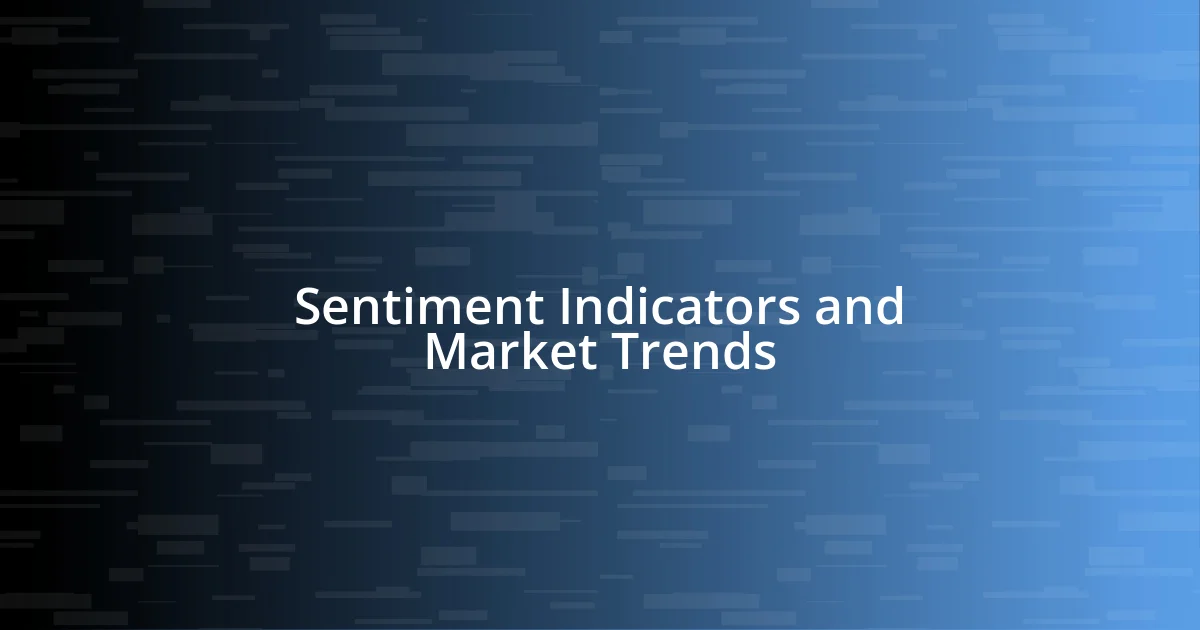Key takeaways:
- Market indicators provide critical insights into economic health, enabling informed investment decisions and effective risk management.
- Understanding both economic indicators (like unemployment rate and CPI) and technical indicators (like MACD and RSI) enhances trading strategies and market analysis.
- Developing a flexible market indicator strategy, backed by clear goals and backtesting against historical data, is essential for adapting to market changes and maximizing investment success.

Understanding Market Indicators
Market indicators are like the pulse of the financial world; they give us insight into the health of the economy and can often guide our investment decisions. Every time I look at the stock market indices, like the S&P 500 or Dow Jones, I feel a mix of anticipation and caution. Have you ever noticed how a single report can send markets soaring or crashing? That’s the power of indicators at play.
I still remember the first time I analyzed employment data and watched how it directly influenced market sentiment. It was a profound moment for me, realizing that the number of jobs created could not only reflect economic stability but also determine my own financial strategies. This connection made me appreciate the depth of market indicators; they aren’t just numbers but rather reflections of the broader economic narrative.
Technical indicators, such as moving averages and relative strength index (RSI), provide a different layer of insight. Have you ever used them to confirm your instincts about a trade? The blend of analytics and instinct is something I find exhilarating. Understanding these tools has transformed how I approach the market, making each decision feel informed, rather than guesswork.

Importance of Market Indicators
Market indicators are essential because they allow investors to gauge economic trends and make informed decisions. I can’t stress enough how invaluable these tools are—they provide a compass in a sea of uncertainty. When I first started investing, I would obsessively track market indicators, often feeling overwhelmed. But as I grew more comfortable, I recognized that they illuminate patterns in price movements and trader behavior, which ultimately shaped my investment strategy.
Here’s why market indicators matter:
- Direction and Trends: They help identify the general direction of the market, allowing me to follow trends rather than fight against them.
- Economic Health: Indicators like GDP growth and unemployment rates give a snapshot of economic health, guiding my long-term investment decisions.
- Market Sentiment: Understanding what drives investor sentiment can give me an edge, especially during periods of volatility.
- Risk Management: By analyzing indicators, I can assess the potential risks in my portfolio, helping to protect my investments during downturns.

Key Economic Indicators to Monitor
Monitoring key economic indicators is crucial for making informed investment decisions. One indicator I always keep an eye on is the unemployment rate. When I first began investing, I remember how every release of employment data felt like a drama unfolding. The way the markets reacted—sometimes with jubilation, other times with despair—taught me that a drop in unemployment can signal economic strength. Yet, I learned that context matters; a low unemployment rate paired with stagnant wage growth can hint at underlying problems, which is why I now check those numbers together.
Another critical indicator is the Consumer Price Index (CPI). For me, understanding inflation’s impact became a game-changer. Back in the day, I would focus solely on stock prices, oblivious to how inflation could erode purchasing power and affect my returns. Now, I actively monitor the CPI because rising inflation can lead to central banks increasing interest rates, which can directly impact the market. That shift in perspective turned the lens on how I perceived investment risks and opportunities, making me more proactive in my strategies.
Lastly, I can’t overlook Gross Domestic Product (GDP) growth. Tracking GDP growth rates has allowed me to compare economic health across different countries and sectors. I vividly remember a time when I misjudged an investment in an emerging market, relying solely on hype. The disappointment taught me that understanding GDP movements gives me a clearer picture of long-term sustainability. It’s fascinating how these seemingly abstract numbers consistently shape market dynamics and inform the decisions I make today.
| Economic Indicator | What It Indicates |
|---|---|
| Unemployment Rate | Health of job market and economic strength |
| Consumer Price Index (CPI) | Inflation trends and purchasing power |
| Gross Domestic Product (GDP) | Overall economic health and growth |

Technical Indicators for Trading
Technical indicators serve as the backbone of my trading strategy. When I look at charts, I often start with the Moving Average Convergence Divergence (MACD). I vividly recall a time when I was uncertain about a trade, but the MACD signals aligned perfectly, showing me a clear buy opportunity. The excitement I felt as the trade played out successfully made me appreciate how powerful the right indicators can be in guiding my decisions.
Another technical indicator I frequently rely on is the Relative Strength Index (RSI). Its ability to indicate overbought or oversold conditions changed my trading approach. I remember feeling anxious about missing a surge in a stock’s price, but the RSI warned me that it was overbought. Trusting that indicator saved me from a potentially costly plunge. Isn’t it fascinating how these seemingly abstract numbers help me tune into market psychology?
Lastly, I can’t overlook Bollinger Bands. They’ve become my go-to for assessing volatility and market strength. Once, during a particularly jittery market week, I noticed the bands tightening, signaling a potential breakout. That anticipation was electrifying! As I prepared for the movement, it became clear to me that understanding these indicators not only shapes my trades but also turns the market into a thrilling game of strategy.

Sentiment Indicators and Market Trends
When analyzing sentiment indicators, I often find my mind buzzing with the energy of market emotions. For instance, I began to see the power of surveys like the Consumer Confidence Index when my own investing decisions were influenced by my gut feelings. There was a time when I dismissed the moods of others, thinking I could chart my course based solely on numbers. But witnessing a spike in consumer confidence during a downturn made me realize how collective sentiment can flip market trends unexpectedly.
Another aspect that truly captivates me is the volatility index, or VIX. The first time I tracked the VIX, I remember feeling like an observer of a thrilling rollercoaster. When the VIX surged, it was as if I could sense the panic running through the market. This personal interaction with fear and uncertainty opened my eyes to the idea that while data offers a clear picture, it’s the sentiment behind those numbers that often drives the market’s heartbeat.
I also can’t overlook the importance of social media sentiment analysis. There was an instance when I noticed a wave of excited chatter around an emerging tech stock. As I took in the buzz, it became clear to me how quickly sentiment could shift perceptions and create bubbles. The experience reinforced my belief: while numbers and charts are vital, tapping into the pulse of market sentiment can be just as crucial for anticipating future trends. Isn’t it fascinating how feelings can sway the market just as much as economic data?

Analyzing Market Indicator Data
When I dive into analyzing market indicator data, I often start by examining historical performance trends. The first time I looked at a stock’s price history, I was amazed by how patterns seemed to repeat themselves over time. Isn’t it intriguing how past performance can sometimes guide future expectations? That insight has shaped my decisions countless times, particularly when identifying entry and exit points.
Another critical aspect is confirming signals through multiple indicators. I can recall a moment when the combination of MACD and RSI alerted me to a significant opportunity. It felt like putting together a puzzle where all the pieces finally clicked into place. Seeing those confirmations gave me the confidence to act decisively, reinforcing the idea that relying on a single indicator can lead to misinterpreted signals.
Finally, I believe contextual factors play a role in interpreting the data reflectively. For instance, I’ve learned to consider economic news releases alongside the indicators I monitor. There was a time when I ignored external factors and placed a bet on what seemed like a strong trend, only to watch it reverse dramatically after negative news hit. That taught me to integrate broader economic context into my analyses, ensuring that I don’t fall prey to the false security of numbers alone. Isn’t it essential to remember that the market is influenced by a myriad of factors beyond just the indicators?

Developing a Market Indicator Strategy
When developing a market indicator strategy, I’ve learned the importance of starting with a clear goal. I remember crafting my first strategy, filled with excitement and uncertainty. I wanted to know when to buy and when to sell stocks, but without a defined purpose, I felt lost in a sea of data. This realization led me to map out my investment objectives, whether it was for short-term gains or long-term stability. Setting clear goals helped me make sense of the indicators I chose to follow.
Another crucial element is backtesting my strategies against historical data. I vividly recall the day I spent hours running simulations of my strategies using past market data. Watching how my hypothetical trades would have performed made me realize the potential for strategies to work—or fail—based on different market conditions. It’s almost like peering through a time machine that gives insights into how real-world volatility can alter outcomes. How can you truly trust a strategy without examining its past performance?
Lastly, I find it incredibly valuable to remain flexible and adaptive in my approach. Early in my investing journey, I fixated on a handful of indicators, believing they were the ultimate truth. However, after a particularly rough period where those indicators failed to signal the market shift, I understood the need to adjust my strategy continuously. Now, I frequently evaluate and refresh my indicators to cater to evolving market dynamics. Isn’t it fascinating how adaptability can often be the key to staying ahead in the unpredictable world of investing?














